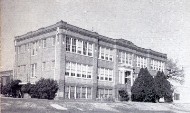




Milam County Historical Commission
Milam County, Texas
Milam County, Texas

Dropping �Little Boy�
Rockdale Man Took Atomic flight into a New Age
�My God, what have we done?�
Enola Gay co-pilot Capt. Robert Lewis
by Patricia Benoit - TELEGRAM STAFF WRITER
When World War II began in late 1941, Joe Stiborik had lofty dreams of serving his
country.
�He wanted to be a pilot, but he was colorblind,� said his daughter, Stephanie Stiborik
Reeves of Cheyenne, Wyo. �He ate lots of carrots � lots and lots of carrots � but he kept
failing the test.�
Then, he enlisted in glider pilot training at Bryan, but the school closed. His flying
days seemed over before they began.
Rockdale resident Stiborik was among those who helped end the war and plunged the world
into the Atomic Age. The lanky first-generation citizen was the radar operator on the
Enola Gay, the plane that dropped the first nuclear bomb on Japan on Aug. 6, 1945. The
only Texan on the flight, he lived, worked and died in Milam County, buried in a simple
grave next to his wife in Rockdale�s I.O.O.F. Cemetery.
Man of few words
A quiet man of few words, Stiborik shunned publicity, rarely talking to news reporters,
never seeking the limelight. Happenstance chiseled him into history books. �He didn�t
talk about it. That was partly because so much of the information was classified for so
many years,� said his younger daughter, Melanie Graves of Houston.
�He was a quiet man by nature � introverted, sweet, reserved. He gave brief answers and
never elaborated. It wasn�t until he passed away that I wished I had talked to him more
about it.�
Born Joseph Anton Stiborik on Dec. 21, 1914, in Hallettsville, he was the son of Anton
and Cecilia Najvar Stiborik, who had immigrated from the Czech highlands. Joe Stiborik
attended Texas A&M and married Helen Coceck on Aug. 1, 1938.
His parents moved to Taylor, where he grew up with three sisters. Stiborik�s father was
the editor of a Czech-language newspaper in Granger. His sister, Cecilia Stiborik Dreyfus
of Ann Arbor, Mich., recalled in 1984, �He was a super-patriotic person. Our family is of
Czech descent, and after Hitler invaded Czechoslovakia, he felt he had to do something.�
Rebuffed in flying school, he volunteered for the Army Air Corps in October 1942, where
he was sent to radar school, Reeves said. He would eventually become a sergeant.
While training in Florida, Stiborik met Col. Paul Tibbets, a gifted but brash pilot who
had completed 43 combat missions in England and North Africa. The Air Corps called
Tibbets stateside to the new B-29 �super fortresses,� then the largest, best-equipped
bombers. By September 1944, Tibbets met with officials of the Navy, Air Corps and the
Manhattan Project, where a new secret weapon was being hatched in New Mexico.
Tibbets admitted later that he didn�t know what an atomic bomb was. �But I knew how to
put an organization together,� he told journalist Studs Terkel.
Birth of the 509th
The result was the 509th Composite Group, remarkable for its youth. One of the �oldest�
crewmembers, Stiborik was 30. Tibbets was his 29-year-old commander. Tibbets handpicked
1,800 of the best pilots, bombardiers, flight engineers, navigators and radar operators �
including Stiborik � for the 509th, enough for 15 B-29 crews. As radar operator,
Stiborik�s job was to help navigate the bomber to the target and to look out for enemy
planes.
�My job, in brief, was to wage atomic war,� Tibbets wrote in his 1989 book �Flight of the
Enola Gay.� Original plans called for dropping simultaneous bombs on Europe and Japan to
quell both fronts.
After several meetings with Manhattan Project scientists, including Robert Oppenheimer,
Tibbets grasped the difficulty of his assignment. Oppenheimer told Tibbets that to
survive the explosion, he would have to turn the massive 74,500-pound B-29 tangent to the
expanding shock wave � 159 degrees in less than 42 seconds. In practice runs, Tibbets and
his crew �practiced turning, steeper, steeper, steeper,� rehearsing quick turns to stave
off bone-shattering concussions.
�The tail was shaking dramatically and I was afraid of it breaking off, but I didn�t
quit. That was my goal. And I practiced and practiced until, without even thinking about
it, I could do it in between 40 and 42, all the time,� Tibbets told Terkel.
By May 1945, the European war was over, but Japan refused to negotiate with Allies.
Tibbets� crew, relocated to Tinian Air Base in the Marianas Islands, received orders
early on Aug. 5.
In a pre-flight briefing on radiation dangers, only Stiborik dared to ask the obvious
question. According to �Our First Atom Bomb: An All-American Story� by Frederick Borsch,
Stiborik spoke up, �Is there any chance this might affect some of us? What I mean is,
could it make us sterile, like we couldn�t have children?�
Tibbets replied, �The family jewels will be just fine.�
By 4 p.m. on Aug. 5, the 12-man crew was ready. Using commander�s privilege, Tibbets
painted his mother�s name on the B-29�s nose, because she encouraged him to fly.
Stiborik, a devout Christian, attended 10 p.m. Catholic Mass.
The 9�-foot bomb that weighed 8,800 pounds was called �Little Boy� by Manhattan Project
scientists, but the Enola Gay crew called it �The Thing.� An implosion nuclear device had
been successfully detonated in July 1945 at the Trinity test in New Mexico, but the B-
29�s type of deadly cargo had never been tested.
�We never did realize, of course, just what we had,� Stiborik said in a rare 1956
newspaper interview. �They tried to tell us about what to expect, showed us pictures
taken at the first bomb test at Alamogordo, (N.M.), but the pictures were in black-
andwhite, and nobody in the crew was actually prepared for what we saw.�
�Hollywood� take-off
Each man was allowed to take a souvenir. Stiborik wore his �good-luck piece,� a Salt Lake
City ski cap. Accompanied by photo and weather planes, the B-29 headed for Japan.
Despite the tight secrecy, still and film cameras recorded the crew�s take-off from
Tinian at 2:30 a.m. on Aug. 6. �The place looked like Hollywood,� Stiborik recalled. �The
big military brass was on hand, everybody was taking pictures and such. The crew had been
working all week, memorizing everything about targets and times, not permitted to carry
any maps or documents with them.�
Halfway into the flight, the crew was told that they were going to �split the atom.�
Tibbets gave each man cyanide pills in case the mission failed and they were captured. If
they refused to take the pills, Tibbets had orders to shoot them. Only then did the crew
realize the importance of their journey.
Closer to Japan, Stiborik�s radar screen locked on a Japanese plane hovering nearby.
Finally, the Enola Gay reached Hiroshima. �Little Boy� was then armed.
�When we cut it loose, the pilot threw the plane into a steep bank to get us out of
there. We were about nine miles away when she went off. We felt two strong concussions. I
thought at first it was flack, but it was the explosion shock waves,� Stiborik said in
1956.
Tibbets later described what he saw. �The Hiroshima bomb did not make a mushroom. It was
what I call a stringer. It just came up. It was black as hell, and it had light and
colors and white in it and gray color in it, and the top was like a folded-up Christmas
tree.�
Stiborik�s radar screen went black. The only words he remembered were from copilot Capt.
Robert Lewis: �My God, what have we done?�
Then, stunned silence.
�It was just too much to express in words, I guess,� Stiborik said. �We were all in a
kind of state of shock. I think the foremost thing in all our minds was that this thing
was going to bring an end to the war, and we tried to look at it that way.�
Back at Tinian
The Enola Gay�s roundtrip took about 12 hours. Two hours after the B-29 landed at Tinian,
the crew heard about the devastation wrought on Hiroshima.
�I was dumbfounded,� Stiborik said. �Remember nobody had ever seen what an A-bomb could
do before. Here was a whole damn town nearly as big as Dallas, one minute all in good
shape and the next minute disappeared and covered with fires and smoke.�
Meanwhile, back home in Taylor, his parents were surprised by hoards of reporters at
their doorstep. Stiborik�s wife, Helen, was living in Oregon. Police woke her at 2 a.m.
and told her to call The Associated Press. Shaking with fear that her husband was killed,
she borrowed a dime to make the call.
Returning to Texas after his November 1945 discharge, Stiborik and his wife settled down
to post-war domesticity, where they reared two daughters. Melanie Graves, his younger
daughter, grew up knowing his story, but not his celebrity. �Our sense of it was that
when he came back, he did not get a hero�s welcome. Some people weren�t as accepting of
(his role). Once the war was over, for the most part, those guys were just sent home.�
He never attended crew reunions, but stayed in touch with individuals over the years, she
added. Even a decade after the bomb the dropped, Stiborik refused to describe �The Thing�
to reporters.
Stiborik never had second thoughts, never had sleepless nights about his participation,
his daughters said. �It was part of a dirty job that somebody had to do. If it hadn�t
been us, somebody else would have had to,� he said.
His older daughter, Stephanie Reeves, recalled having a quiet, normal life.
�He wasn�t a publicity hound. He felt it was a job he had to do, and that was it. He
didn�t dwell on it. He was willing to die to stop the war. They knew they might die, but
they did it. He was like all the others who served in Europe and the Pacific or who
fought on D-Day. You have to admire the bravery of every single person who fought in that
war,� she said.
Moved to Rockdale
The Stiborik family later moved to Rockdale, where he worked for Industrial Generating
Co., part of Alcoa. The only indication of his war service was a simple framed picture of
the Enola Gay hanging in his office.
Stiborik died of a heart attack at age 69 at his Rockdale home on June 30, 1984.
Throughout his life, he remained a solid family man who attended church and served his
community.
Helen Stiborik stashed away clippings, military medals, silk maps and flight logs in a
big trunk, which Reeves now has.
�And I still have the keys,� Reeves said.
The keys?
�Yes, �she replied. �About a week before their flight, the plane was based at Guam. My
father and a pilot flew it from Guam to Tinian. After they landed, the pilot threw the
keys to my father, and he put them in his pocket. I guess he forgot about them. I still
have the keys to the Enola Gay.�
pbenoit@tdtnews.com
The ground crew of the B-29 Enola Gay, posing for a photograph on Marianas Islands in Guan, atom-bombed Hiroshima, Japan. Co. Paul W. Tibbets, the pilot, is standing second from the right. The entire Enola Gay's flying crew on August 6, 1945 consisted of 12 men. Rockdale resident Sgt. Joe Stiborik kneels second from the left.
photo credit: National Archives
.

All articles from the Temple Daily Telegram are published with the permission of the
Temple Daily Telegram.
All credit for this article goes to
Patricia Benoit and the Temple Daily Telegram
Temple Daily Telegram.
All credit for this article goes to
Patricia Benoit and the Temple Daily Telegram